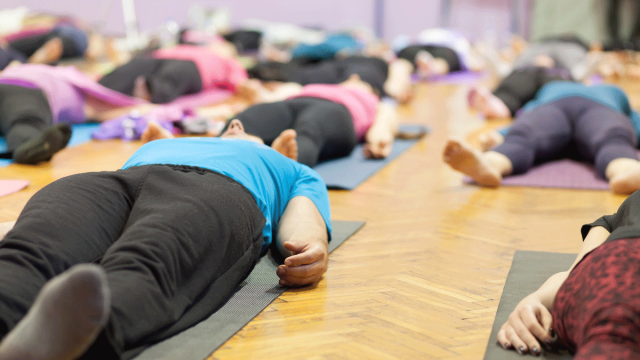After two years of the pandemic, virtual classrooms, virtual boardrooms, making plans, cancelling plans, re-thinking where we live and oh, parenting—we are just. so. tired. Which is why America’s newest fitness trend is one we can really get behind: a good rest.
Not only are fitness centers responding to America’s exhaustion level by rolling out gentler classes like yoga and meditation, but they’re also creating dedicated “recovery” spaces full of things that you’ll never want to leave. Massage lounge chairs, stables of massage guns, pillows and calming music are all popping up in corners of gyms that used to be halogen-lit and lycra infused.
Russ Frank told The Wall Street Journal that his evening workout reminds him of preschool nap time. There’s a mat, pillows, dim lighting and a soft-spoken instructor who suggests stretches while calming music plays. His class is named Surrender, and is an hourlong, restorative class with a waitlist. His gym, part of the Life Time Group Holdings Inc. chain, offered the class in 2019, but since its inception has increased it on the schedule by about 50% across it’s multiple national locations. “I always thought a workout required me to sweat,” says Mr. Frank. “Being still has its own benefits.”
#MondayMotivation 💎 pic.twitter.com/G4hC0PlIgM
— Crunch Fitness (@CrunchGym) March 21, 2022
The American gym—once a factory for looking better and often offering tanning beds, high-intensity fat burning classes, body sculpting sessions and the like—has turned its focus away from how it’s members look, and set its sights on how its members feel. And let’s be honest, a couple of years in lounge attire coupled with bouts of stress eating and we’re all pretty excited about the new message coming from Fitnesslandia.
Mindbody App recentley surveyed 16,000 Americans; reports show that 43% are exercising to feel better and 59% to reduce stress. Plus, offering classes that limit the use of “Blast,” “Burn,” and “Kamikaze” makes it that much easier for people who have gotten out of shape to get back into the swing of things.
“Leaving it all on the gym floor doesn’t seem like a priority as much,” says Marc Santa Maria, national director of group fitness for Crunch Signature. People are no longer taking a no pain, no gain approach to fitness, he says. Right. Because that sort of became our mantra to get through the past two years of life in general, so why would we need to adopt it now, at the gym, too?
https://www.instagram.com/p/CWBLWmNgE5e/
You’ll also find “rest and recover” areas at Crunch facilities—featuring massage chairs and high-tech massage gadgets—and they’ve got plans to roll them out to additional facilities throughout 2022. Crunch isn’t alone. Life Time gyms now has “recovery zones” in 22 of its 150 locations in the U.S. and Canada. Karl Sanft, CEO of 24 Hour Fitness says it has increased its recovery classes 33% since the summer of 2021 as demand has surged.
Use of compression boots, self-massage tools and HydroMassage loungers, introduced in 2018, has quadrupled since the start of the year, says Tom Manella, vice president of personal training at Life Time. Dedicated recovery zones will be built into all new clubs, he says, adding “We’re seeing the same customer return, but they’ve come out of the pandemic less focused on looking good at the pool and losing weight.”
RELATED STORIES
80% of People Would Rather Change Careers Than Work In-Person Full Time Again
The Impact of the Global Pandemic on Your Family’s Mental Health
How to Work from Home & Still Be Involved with Your Kids (It’s Possible!)











